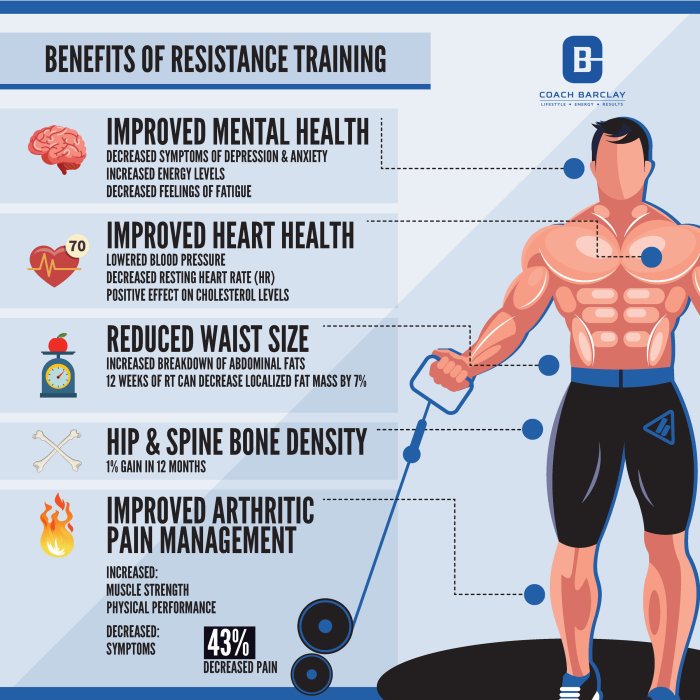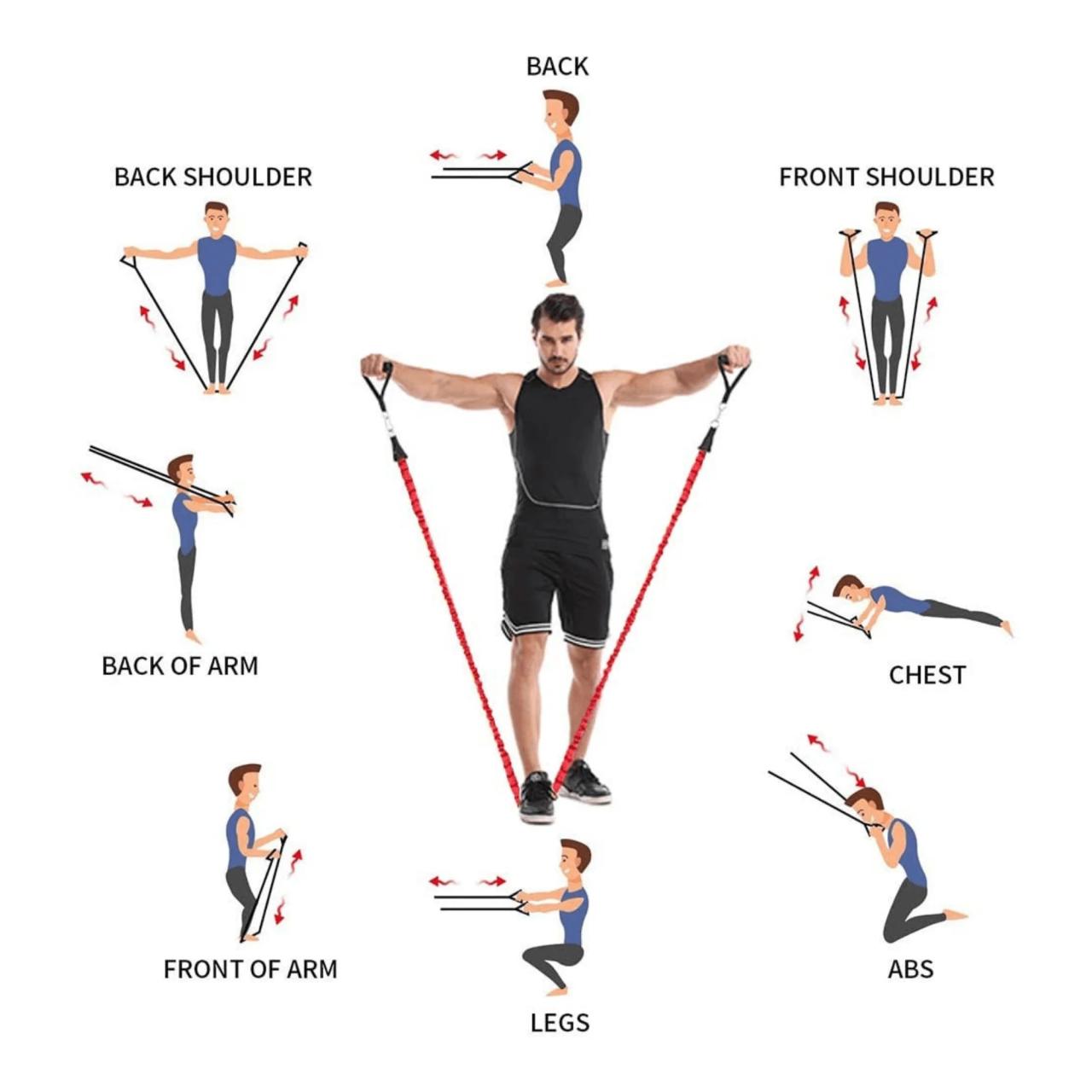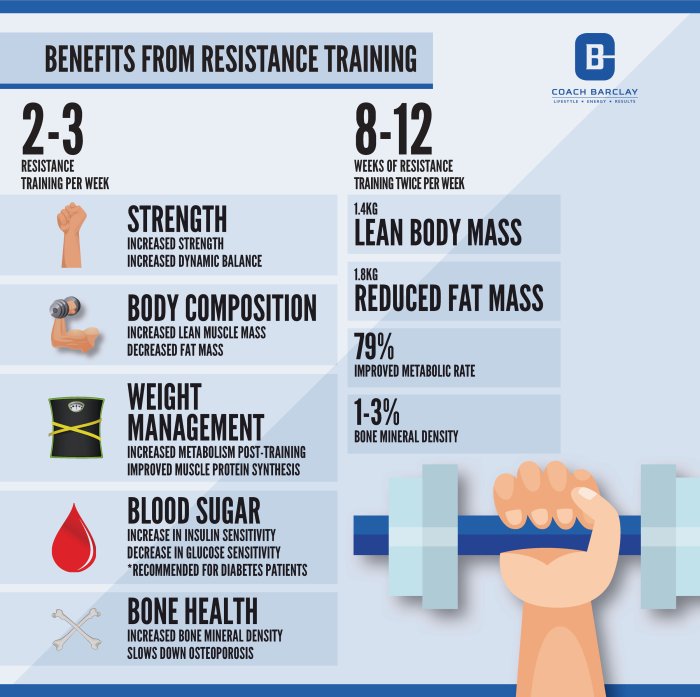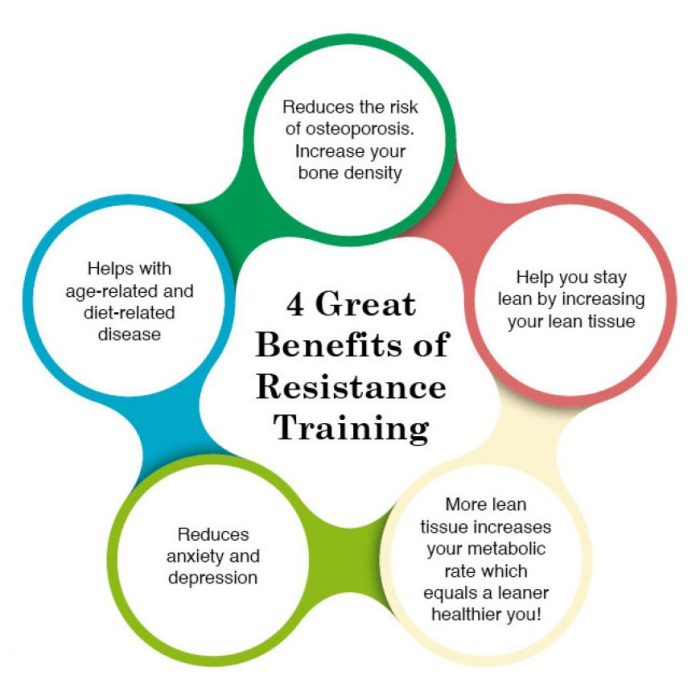Benefits of resistance exercise – In the realm of fitness, resistance exercise reigns supreme, offering a multitude of benefits that empower individuals to achieve their health and wellness goals. Join us as we delve into the transformative power of resistance training, exploring its profound impact on muscles, bones, metabolism, and overall well-being.
From building lean muscle mass to strengthening bones and boosting metabolism, resistance exercise is a cornerstone of a healthy lifestyle. Whether you’re a seasoned athlete or just starting your fitness journey, incorporating resistance training into your routine can unlock a world of benefits that will elevate your physical and mental health to new heights.
Introduction
Resistance exercise is a form of exercise that involves working against an external force, such as weights, bands, or your own body weight. It is an essential component of a well-rounded fitness program and offers numerous benefits for overall health and well-being.Resistance exercise helps to build and maintain muscle mass, which is important for strength, mobility, and balance.
It also helps to improve bone density, reduce body fat, and boost metabolism. Additionally, resistance exercise can improve cardiovascular health, reduce the risk of chronic diseases, and enhance cognitive function.Physiological adaptations that occur with resistance exercise include increased muscle protein synthesis, improved muscle fiber recruitment, and enhanced neuromuscular coordination.
These adaptations lead to increased strength, power, and endurance.Progressive overload is a key principle of resistance exercise training. It involves gradually increasing the weight, sets, repetitions, or exercise intensity over time to continue challenging the muscles and promote further adaptations.
Benefits for Muscle Health

Resistance exercise is crucial for maintaining and improving muscle health throughout your life. It plays a vital role in building and maintaining muscle mass, enhancing strength and power, and improving muscle endurance. These benefits contribute to overall physical function, mobility, and quality of life.
Building and Maintaining Muscle Mass
As we age, we naturally lose muscle mass, a condition known as sarcopenia. Resistance exercise helps counteract this process by stimulating muscle protein synthesis, the process by which new muscle tissue is created. By engaging in regular resistance training, you can maintain or even increase muscle mass, which is essential for strength, mobility, and metabolic health.
Enhancing Muscle Strength and Power
Resistance exercise increases muscle strength and power by overloading the muscles and forcing them to adapt. When you lift weights or perform other forms of resistance exercise, you create tiny tears in the muscle fibers. During recovery, the body repairs these tears and builds them back stronger, leading to increased strength and power.
Improving Muscle Endurance, Benefits of resistance exercise
Muscle endurance refers to the ability of your muscles to perform repeated contractions over an extended period. Resistance exercise can improve muscle endurance by increasing the number of mitochondria in muscle cells. Mitochondria are the powerhouses of the cells and provide the energy needed for muscle contractions.
By increasing the number of mitochondria, resistance exercise enhances the muscles’ ability to sustain activity for longer durations.
Benefits for Bone Health
Resistance exercise plays a vital role in maintaining and improving bone health. It helps promote bone density, reduce the risk of osteoporosis, and improve overall skeletal integrity.
Mechanisms
Resistance exercise exerts mechanical stress on bones, which stimulates the body to increase bone formation and mineralization. This process leads to increased bone density and strength, reducing the risk of fractures.
Osteoporosis Prevention
Osteoporosis is a condition characterized by weak and brittle bones. Resistance exercise has been shown to be effective in reducing the risk of osteoporosis by increasing bone density and improving bone structure.
Optimal Exercise Types and Intensities
The most effective resistance exercises for bone health are those that involve weight-bearing and impact. These exercises include:
- Weightlifting
- Bodyweight exercises (e.g., push-ups, squats)
- Jumping exercises
The optimal intensity for resistance exercise is moderate to high, with 8-12 repetitions per set.
Specific Exercises
Here are some specific resistance exercises that are beneficial for bone health:
- Barbell squats
- Dumbbell lunges
- Push-ups
- Pull-ups
- Jumping jacks
Summary Table
The following table summarizes the key findings on the relationship between resistance exercise and bone health:
| Benefit | Evidence |
|---|---|
| Increased bone density | Studies have shown that resistance exercise can increase bone density in both men and women. |
| Reduced risk of osteoporosis | Resistance exercise has been shown to reduce the risk of osteoporosis by increasing bone density and improving bone structure. |
| Improved skeletal integrity | Resistance exercise can help improve overall skeletal integrity by increasing bone strength and reducing the risk of fractures. |
Benefits for Metabolism: Benefits Of Resistance Exercise

Resistance exercise offers significant benefits for metabolism, aiding in fat loss, improving insulin sensitivity, and promoting weight management.
By increasing muscle mass, resistance exercise boosts the body’s metabolic rate, resulting in a higher number of calories burned both during and after workouts. This increased muscle mass serves as an active tissue, constantly consuming energy and contributing to a faster metabolism.
Role in Fat Loss
Resistance exercise directly targets body fat, reducing its percentage and improving overall body composition. It helps in building lean muscle, which not only enhances metabolism but also contributes to fat loss.
Improving Insulin Sensitivity and Glucose Tolerance
Resistance exercise plays a crucial role in improving insulin sensitivity, allowing the body to utilize glucose more efficiently. Enhanced insulin sensitivity helps in controlling blood sugar levels, reducing the risk of insulin resistance and type 2 diabetes.
Benefits for Weight Management
Resistance exercise is an effective tool for weight management. By increasing muscle mass and boosting metabolism, it promotes a caloric deficit, making it easier to maintain a healthy weight. Additionally, resistance exercise helps in preserving muscle during weight loss, preventing the loss of muscle mass that can occur with traditional dieting methods.
Benefits for Cardiovascular Health
Resistance exercise offers significant benefits for cardiovascular health. It helps reduce blood pressure, improve lipid profiles, and lower the risk of cardiovascular disease.
Evidence Supporting Blood Pressure Reduction:Studies have shown that resistance exercise can effectively reduce both systolic and diastolic blood pressure. A meta-analysis of 26 studies found that resistance training lowered systolic blood pressure by an average of 5.5 mmHg and diastolic blood pressure by 3.2 mmHg.
Improved Lipid Profiles
Resistance exercise improves lipid profiles by increasing high-density lipoprotein (HDL) cholesterol and decreasing low-density lipoprotein (LDL) cholesterol. HDL cholesterol helps remove excess cholesterol from the arteries, while LDL cholesterol can contribute to plaque buildup.
Underlying Mechanisms:The cardiovascular benefits of resistance exercise are attributed to several mechanisms, including improved blood flow, reduced inflammation, and enhanced endothelial function. Resistance exercise increases blood flow to the heart and blood vessels, which can help lower blood pressure and improve oxygen delivery to tissues.
Benefits for Neurological Health
Resistance exercise has been shown to have a range of cognitive benefits, including improved memory and executive function. For instance, a study published in the journal Frontiers in Aging Neuroscience found that older adults who engaged in resistance training for six months experienced significant improvements in their working memory, which is the ability to hold and manipulate information in the mind.Resistance exercise may also play a role in reducing the risk of neurodegenerative diseases, such as Alzheimer’s and Parkinson’s.
A study published in the journal Neurology found that people who engaged in regular resistance exercise had a 40% lower risk of developing Alzheimer’s disease than those who did not exercise.The mechanisms by which resistance exercise improves brain health are not fully understood, but it is thought to involve increased blood flow to the brain, neurogenesis (the growth of new neurons), and synaptic plasticity (the ability of synapses to change in response to experience).
Table: Key Cognitive Benefits of Resistance Exercise
| Type of Exercise | Intensity | Duration | Frequency ||—|—|—|—|| Compound exercises (e.g., squats, deadlifts, bench press) | Moderate to high | 8-12 repetitions | 2-3 times per week |
Practical Tips for Incorporating Resistance Exercise into a Fitness Routine for Optimal Neurological Health
- Start slowly and gradually increase the weight and intensity of your workouts over time.
- Focus on compound exercises that work multiple muscle groups simultaneously.
- Aim for 8-12 repetitions of each exercise, and complete 2-3 sets of each exercise.
- Rest for 1-2 minutes between sets.
- Warm up before your workout and cool down afterward.
- Listen to your body and stop if you experience any pain.
Benefits for Mental Health
Resistance exercise is not just beneficial for your physical health, but also for your mental well-being. Studies have shown that it can reduce symptoms of depression and anxiety, and improve mood and self-esteem.
The mechanisms underlying these benefits are not fully understood, but several factors are thought to play a role. First, resistance exercise releases endorphins, which have mood-boosting effects. Second, it can help to reduce stress and improve sleep quality, both of which are important for mental health.
Finally, resistance exercise can increase self-confidence and self-esteem, which can also contribute to improved mental well-being.
Mood and Self-Esteem
- Resistance exercise can help to improve mood by releasing endorphins, which have mood-boosting effects.
- It can also help to reduce stress and improve sleep quality, both of which are important for mental health.
- Finally, resistance exercise can increase self-confidence and self-esteem, which can also contribute to improved mental well-being.
Benefits for Functional Fitness
Resistance exercise plays a pivotal role in enhancing functional fitness, which refers to the ability to perform everyday activities with ease and efficiency. It improves balance, coordination, and flexibility, making daily tasks less challenging and more enjoyable.
Resistance exercise strengthens the muscles involved in everyday movements, such as lifting, reaching, and squatting. By improving muscle strength and endurance, resistance exercise allows individuals to perform these activities with greater ease and reduce the risk of injuries.
Benefits of Resistance Exercise for Functional Fitness
- Improved balance and coordination
- Enhanced flexibility
- Increased muscle strength and endurance
- Reduced risk of injuries
- Improved ability to perform everyday activities
Specific Examples of Functional Exercises
Incorporating functional exercises into a resistance training program can significantly improve daily activities. Here are some examples:
- Squats: Strengthens the legs and improves balance
- Lunges: Improves leg strength, flexibility, and coordination
- Push-ups: Strengthens the upper body and core
- Pull-ups: Strengthens the back and improves grip strength
- Planks: Strengthens the core and improves posture
Table: Comparison of Resistance Exercise to Other Forms of Exercise for Functional Fitness
| Exercise Type | Benefits for Functional Fitness ||—|—|| Resistance Exercise | Improves balance, coordination, flexibility, and muscle strength || Aerobic Exercise | Improves cardiovascular health and endurance || Flexibility Exercises | Improves range of motion and flexibility || Balance Exercises | Improves balance and coordination |
Top 5 Benefits of Resistance Exercise for Functional Fitness
- Improved balance and coordination
- Enhanced flexibility
- Increased muscle strength and endurance
- Reduced risk of injuries
- Improved ability to perform everyday activities
Benefits for Injury Prevention
Resistance exercise plays a pivotal role in reducing the risk of injuries by strengthening muscles, tendons, and ligaments, making them more resilient to withstand forces and prevent sprains, strains, and tears.
Stronger muscles can better control joint movements, reducing the risk of instability and falls. Strengthened tendons and ligaments provide better support and stability to joints, making them less susceptible to injuries.
Specific Types of Resistance Exercise for Injury Prevention
- Compound exercises:These exercises work for multiple muscle groups simultaneously, improving overall strength and stability. Examples include squats, lunges, and push-ups.
- Eccentric exercises:These exercises involve lengthening the muscle as it contracts, increasing strength and resilience. Examples include lowering the weight during a bicep curl or squatting down.
- Plyometric exercises:These exercises involve rapid muscle contractions, improving power and explosiveness. Examples include jumping, hopping, and bounding.
- Balance exercises:These exercises challenge stability and coordination, improving overall balance and reducing the risk of falls. Examples include standing on one leg or performing balance board exercises.
Benefits for Aging
As we age, it’s essential to maintain muscle mass and strength. Resistance exercise can help preserve and even increase muscle mass, which is crucial for mobility, balance, and overall health. It also reduces the risk of falls and fractures in older adults.
Reduced Risk of Falls and Fractures
Resistance exercise strengthens bones and muscles, making them less susceptible to injury. Stronger muscles improve balance and coordination, reducing the likelihood of falls. Increased bone density helps prevent fractures, especially in the hips and spine, which are common sites of fractures in older adults.
Improved Quality of Life
Resistance exercise can significantly enhance the quality of life in older adults. It improves physical function, reduces pain, and boosts energy levels. This allows older adults to engage in activities they enjoy, maintain independence, and live fulfilling lives.
Recommended Exercises for Older Adults
Suitable resistance exercises for older adults include:
- Bodyweight exercises: Squats, push-ups, and lunges
- Resistance bands: Bicep curls, shoulder presses, and rows
- Dumbbells or kettlebells: Deadlifts, squats, and overhead presses
Incorporating Resistance Exercise into a Routine
Older adults can incorporate resistance exercise into their daily routines in various ways:
- Join a group exercise class designed for seniors
- Work with a personal trainer who specializes in working with older adults
- Perform bodyweight exercises at home using chairs or walls for support
Resistance exercise is a vital component of a healthy aging plan. By preserving muscle mass, reducing the risk of falls and fractures, and improving overall quality of life, it empowers older adults to live active and fulfilling lives.
Benefits for Specific Populations

Resistance exercise offers remarkable benefits for individuals with chronic conditions such as arthritis, diabetes, and obesity. It can significantly improve mobility, reduce pain, and enhance overall health in these populations.
Arthritis
Resistance exercise can help reduce pain and stiffness, improve range of motion, and strengthen muscles around the affected joints in individuals with arthritis. Specific exercises tailored to the type of arthritis can help stabilize joints, reduce inflammation, and improve overall function.
Diabetes
Resistance exercise can improve insulin sensitivity, reduce blood glucose levels, and promote weight management in individuals with diabetes. By increasing muscle mass, resistance exercise helps the body use insulin more effectively, leading to better blood sugar control.
Obesity
Resistance exercise is a crucial component of weight management programs for individuals with obesity. It helps build muscle mass, which increases the body’s metabolic rate and aids in calorie burn. Resistance exercise also improves insulin sensitivity, reducing the risk of developing type 2 diabetes.
Optimal Resistance Exercise Programs

To design effective resistance exercise programs, it’s essential to consider exercise intensity, frequency, and volume. Intensity refers to the weight or resistance used, frequency is how often you train, and volume is the total amount of work performed. A well-rounded program should include exercises that target all major muscle groups, with each exercise performed for 8-12 repetitions per set.
It’s crucial to gradually progress your resistance exercise program over time. Start with a weight or resistance that is challenging but allows you to maintain good form. As you get stronger, increase the weight or resistance to continue challenging your muscles.
Recommended Guidelines for Resistance Exercise Programming
| Variable | Beginner | Intermediate | Advanced |
|---|---|---|---|
| Intensity | 60-70% of 1RM | 70-85% of 1RM | 85-100% of 1RM |
| Frequency | 2-3 times per week | 3-4 times per week | 4-5 times per week |
| Volume | 8-12 repetitions per set | 10-15 repetitions per set | 12-20 repetitions per set |
Key Points to Remember When Designing Resistance Exercise Programs
- Start with a weight or resistance that is challenging but allows you to maintain good form.
- Gradually increase the weight or resistance over time as you get stronger.
- Include exercises that target all major muscle groups.
- Perform each exercise for 8-12 repetitions per set.
- Train 2-5 times per week, depending on your fitness level and goals.
- Allow for adequate rest and recovery between workouts.
- Focus on proper form and technique to prevent injuries and maximize results.
Importance of Proper Form and Technique
Proper form and technique are essential for safe and effective resistance exercise. Using improper form can increase your risk of injury and reduce the effectiveness of your workouts. When performing resistance exercises, always focus on maintaining a neutral spine, keeping your core engaged, and moving through a full range of motion.
Role of Rest and Recovery
Rest and recovery are just as important as the resistance exercise itself. During rest, your muscles repair and rebuild, preparing them for your next workout. Aim for 24-48 hours of rest between workouts for each muscle group.
Sample Resistance Exercise Programs
The following are sample resistance exercise programs for different fitness levels and goals:
- Beginner:2-3 days per week, full-body workouts with 8-12 repetitions per set.
- Intermediate:3-4 days per week, split routines (e.g., upper body/lower body) with 10-15 repetitions per set.
- Advanced:4-5 days per week, advanced routines (e.g., powerlifting, bodybuilding) with 12-20 repetitions per set.
Benefits of Resistance Exercise Programs for Overall Health and Fitness
- Increased muscle mass and strength
- Improved bone density
- Enhanced metabolism
- Reduced risk of cardiovascular disease
- Improved neurological function
- Boosted mental health
- Increased functional fitness
- Reduced risk of injuries
- Improved quality of life
Safety Considerations

Resistance exercise offers numerous benefits, but it’s crucial to be aware of potential risks and take precautions to minimize them.
Improper form, excessive weight, or inadequate warm-up can lead to injuries such as muscle strains, joint pain, or even cardiovascular events.
Warming Up Properly
Warming up prepares your body for the demands of resistance exercise. Begin with light cardio and dynamic stretching to increase blood flow and muscle flexibility.
Proper Form
Using proper form ensures you target the intended muscles while minimizing strain on joints. Consult a fitness professional for guidance on correct technique.
Appropriate Weight Selection
Choose weights that challenge you without compromising form. Start with a weight that allows you to maintain good form throughout the entire set.
Cooling Down Properly
Cooling down helps your body recover by reducing heart rate and muscle tension. Engage in light cardio and static stretching after your workout.
Specific Health Conditions
Individuals with certain health conditions may require modifications to their resistance exercise program. Consult a healthcare provider before starting:
- Pregnant women
- Individuals with heart conditions
- Individuals with joint pain
- Individuals with osteoporosis
Professional Guidance
It’s highly recommended to seek guidance from a healthcare provider or fitness professional before starting a resistance exercise program. They can assess your fitness level, identify any limitations, and provide personalized recommendations to ensure your safety.
Conclusion
Resistance exercise offers a plethora of benefits that contribute to overall health and well-being. By incorporating resistance training into a regular fitness routine, individuals can enhance their physical capabilities, reduce the risk of chronic diseases, improve mental health, and promote longevity.
The key benefits of resistance exercise can be summarized as follows:
- Improved muscle strength and endurance
- Increased bone density and reduced risk of osteoporosis
- Boosted metabolism and weight management
- Reduced risk of cardiovascular disease and improved heart health
- Enhanced cognitive function and reduced risk of neurological disorders
- Improved mental well-being and reduced symptoms of depression and anxiety
- Increased functional fitness and improved daily activities
- Reduced risk of injuries and improved recovery from injuries
- Preservation of muscle mass and mobility as we age
Incorporating resistance exercise into a regular fitness routine is essential for maintaining a healthy and active lifestyle. Individuals of all ages and fitness levels can benefit from resistance training. By engaging in resistance exercise, individuals can unlock the numerous benefits it offers and improve their overall health and well-being.
Wrap-Up
Incorporating resistance exercise into your fitness regimen is not just a choice; it’s an investment in your overall health and well-being. Embrace the transformative power of resistance training and witness the remarkable benefits it brings to your physical, mental, and emotional health.
Remember, every rep, every set, and every workout is a step towards a stronger, healthier, and more fulfilling life.
Expert Answers
How often should I do resistance exercise?
Aim for 2-3 sessions per week, targeting different muscle groups each session.
What is the best type of resistance exercise for beginners?
Bodyweight exercises, such as squats, push-ups, and lunges, are a great starting point.
Can resistance exercise help me lose weight?
Yes, resistance exercise can increase muscle mass and boost metabolism, which can aid in weight loss.
Is resistance exercise safe for older adults?
Yes, resistance exercise is beneficial for older adults, helping to maintain muscle mass, improve balance, and reduce the risk of falls.
Can resistance exercise improve my mental health?
Yes, resistance exercise has been shown to reduce symptoms of depression and anxiety, and improve mood and self-esteem.
Leave a Reply